FishProfiles.com Message Forums |
| faq | etiquette | register | my account | search | mailbox |
| Lowest cost and easiest way to eliminate green hair, bubble, turf and slime algae from your aquarium (hopefully permanently) | |
FRANK                Moderator Posts: 5108 Kudos: 5263 Votes: 1690 Registered: 28-Dec-2002    | Hi, I prefer the "Otto's. " http://www.otocinclus.com/ They are a small fish that spend their time eating as much algae as they can find. They will swarm over the glass as well as any other stationary ob Hope this helps... Frank  -->>> The Confidence of Amateurs, is the Envy of Professionals <<<-- |
| SantaMonicaHelp Fingerling Posts: 22 Kudos: 7 Votes: 0 Registered: 29-Sep-2012  | 1982: The original dump-bucket style algae scrubber (works, but very hard to build, install, operate, and harvest) 2008: Waterfall style algae scrubber (works good but hard to build and install; must be removed to harvest) 2011: Upflow style scrubber (work goods, easier to build and install on the glass; must be removed to harvest) 2013: ??? (work great, all 3D growth, easy to build, and instant in-place harvesting without needing to remove anything or turn anything off). Research Studies: Reefba |
| SantaMonicaHelp Fingerling Posts: 22 Kudos: 7 Votes: 0 Registered: 29-Sep-2012  | If anyone has been waiting to build a waterfall or upflow scrubber, we will soon be posting plans of the new floating surface scrubber. It floats at the top and does not need a waterfall, and it does not shine through the glass. Research Studies: Reefba |
santamonica Enthusiast Posts: 152 Kudos: 17 Registered: 19-Sep-2008   | Thanks for the Otto's. I'll add them to the Pleco's  888-CORAL-REEF Filtering discussion: www.AlgaeScrubber.net |
santamonica Enthusiast Posts: 152 Kudos: 17 Registered: 19-Sep-2008   |  888-CORAL-REEF Filtering discussion: www.AlgaeScrubber.net |
| SantaMonicaHelp Fingerling Posts: 22 Kudos: 7 Votes: 0 Registered: 29-Sep-2012  | |
santamonica Enthusiast Posts: 152 Kudos: 17 Registered: 19-Sep-2008   | Come tell us what you think about our new HOG scrubber Kickstarter... http://www.kickstarter.com/projects/1079197168/1221025490?token=347e500b 888-CORAL-REEF Filtering discussion: www.AlgaeScrubber.net |
santamonica Enthusiast Posts: 152 Kudos: 17 Registered: 19-Sep-2008   | More harvests from the floating surface scrubber: http://youtu.be/miWb4R8ajXw 888-CORAL-REEF Filtering discussion: www.AlgaeScrubber.net |
santamonica Enthusiast Posts: 152 Kudos: 17 Registered: 19-Sep-2008   | Phosphate flow out of rocks Many people, when they get their scrubber running for the first time, get worried when more (not less) algae starts to grow on their rocks. It seems really strange, especially when nitrate and phosphate have gone lower than before. What is happening is that phosphate is coming out of the rocks. Remember, phosphate is invisible, so you can only see the effects of it, and it always "flows" from higher concentrations to lower concentrations (just like heat does). Example: If your room is warm, and you put a cold ob Think of phosphate as the heat, and your rocks as the ob This flow causes an interesting thing to happen. As the phosphate comes out of the rocks, it then becomes available to feed algae as soon as the phosphate reaches the surface of the rocks where there is light. So, since the surface of the rocks is rough and has light, it starts growing MORE algae there (not less) as the phosphate comes out of the rocks. This is a pretty amazing thing to see for the first time, because if you did not know what was happening you would probably think that the algae in the scrubber was leaking out and attaching to your rocks. Here are the signs of phosphate coming out of the rocks: 1. The rocks are older, and have slowly developed algae problems in the past year. 2. The scrubber is new, maybe only a few months old, and has recently started to grow well. 3. Nitrate and phosphate measurements in the water are low, usually the lowest they have been in a long time. 4. Green hair algae (not brown) on the rocks has increased in certain spots, usually on corners and protrusions at the top. 5. The glass has not needed cleaning as much. Since skimmers, filter socks, etc don't remove any nitrate and phosphate, and waterchanges and macro's in a fuge don't remove much, most people have never seen the effects of large amounts of phosphate coming out of the rocks quickly. But sure enough, it does. How long does it continue? For 2 months to a year, depending on how much phosphate is in the rocks, how strong your scrubber is, and how many other phosphate-removing filters you have (GFO, carbon dosing, etc). But one day you will see patches of white rock that were covered in green hair the day before; this is a sure sign that the algae are losing their phosphate supply from the rocks and can no longer hold on. Now it's just a matter of days before the rocks are clear. 888-CORAL-REEF Filtering discussion: www.AlgaeScrubber.net |
santamonica Enthusiast Posts: 152 Kudos: 17 Registered: 19-Sep-2008   | Advanced Aquarist Feature Article for December 2013: Coral Feeding: An Overview http://www.advancedaquarist.com/2013/12/aafeature The picture in the article shows that in the 1000 litre test tank: 98% of the food particles go to the skimmer when there are 2 coral colonies 71% of the food particles go to the skimmer when there are 40 coral colonies 92% of the food particles go to the skimmer when there are 2 coral colonies, when skimming is cut in half 55% of the food particles go to the skimmer when there are 40 coral colonies, when skimming is cut in half "This trade-off between food availability and water quality can be circumvented by using plankton-saving filtration systems, which include [...] algal turf scrubbers" "Corals are able to feed on a wide range of particulate organic matter, which includes live organisms and their residues and excrements (detritus)." "...bacteria [...] can be a major source of nitrogen." "...when dry fish feeds or phytoplankton cultures are added to an aquarium, a part of this quickly ends up in the collection cup of the skimmer. "...mechanical filters (which can include biofilters and sand filters) result in a significant waste of food." "Detritus is a collective term for organic particles that arise from faeces, leftover food and decaying organisms. Detrital matter is common on coral reefs and in the aquarium, and slowly settles on the bottom as sediment. This sediment contains bacteria, protozoa, microscopic invertebrates, microalgae and organic material. These sedimentary sources can all serve as coral nutrients when suspended, especially for species growing in turbid waters. Experiments have revealed that many scleractinian corals can ingest and assimilate detritus which is trapped in coral mucus. Although stony corals may ingest detritus when it is available, several gorgonians have been found to primarily feed on suspended detritus." "Dissolved organic matter (DOM) is an important food source for many corals. [...] scleractinian corals take up dissolved glucose from the water. More ecologically relevant, corals can also absorb amino acids and urea from the seawater" 888-CORAL-REEF Filtering discussion: www.AlgaeScrubber.net |
santamonica Enthusiast Posts: 152 Kudos: 17 Registered: 19-Sep-2008   | Big harvests! (note: FW does not grow as thick) http://youtu.be/2GGXoAcmA7E 888-CORAL-REEF Filtering discussion: www.AlgaeScrubber.net |
| SantaMonicaHelp Fingerling Posts: 22 Kudos: 7 Votes: 0 Registered: 29-Sep-2012  | Great video showing a basic upflow scrubber, similar to a Hang-On-Glass (tm)... http://www.youtube.com/watch?v=qGLnBvDkaO0 Research Studies: Reefba |
| SantaMonicaHelp Fingerling Posts: 22 Kudos: 7 Votes: 0 Registered: 29-Sep-2012  | Nutrient Export What do all algae (and cyano too) need to survive? Nutrients. What are nutrients? Ammonia/ammonium, nitrite, nitrate, phosphate and urea are the major ones. Which ones cause most of the algae in your tank? These same ones. Why can't you just remove these nutrients and eliminate all the algae in your tank? Because these nutrients are the result of the animals you keep. So how do your animals "make" these nutrients? Well a large part the nutrients come from pee (urea). Pee is very high in urea and ammonia, and these are a favorite food of algae and some bacteria. This is why your glass will always need cleaning; because the pee hits the glass before anything else, and algae on the glass consume the ammonia and urea immediately (using photosynthesis) and grow more. In the ocean and lakes, phytoplankton consume the ammonia and urea in open water, and seaweed consume it in shallow areas, but in a tank you don't have enough space or water volume for this, and, your other filters or animals often remove or kill the phytoplankton or seaweed anyway. So, the nutrients stay in your tank. Then the ammonia/ammonium hits your rocks, and the periphyton on them consumes more ammonia and urea. Periphyton is both algae and animals, and is the reason your rocks change color after a few weeks. Then the ammonia goes inside the rock, or hits your sand, and bacteria there convert it into nitrite and nitrate. However, the nutrients are still in your tank. Also let's not forget phosphate, which comes from solid organic food particles. When these particles are eaten by microbes and clean up crew, the organic phosphorus in them is converted into phosphate. However, the nutrients are still in your tank. So whenever you have algae "problems", you simply have not exported enough nutrients compared to how much you have been feeding (note: live rock can absorb phosphate for up to a year, making it seem like there was never a problem. Then, there is a problem). So just increase your nutrient exports. You could also reduce feeding, and this has the same effect, but it's certainly not fun when you want to feed your animals  Research Studies: Reefba |
santamonica Enthusiast Posts: 152 Kudos: 17 Registered: 19-Sep-2008   | From new to green, in 3 cleanings and 2 LEDs... http://www.youtube.com/watch?v=utu2SADmj2g 888-CORAL-REEF Filtering discussion: www.AlgaeScrubber.net |
santamonica Enthusiast Posts: 152 Kudos: 17 Registered: 19-Sep-2008   | Very nice scrubber-only tank, although is FW: http://algaescrubber.net/forums/showthread.php?2702-180g-Show-Tank&p=35853&viewfull=1#post35853 His personal page: http://home.comcast.net/~dgrigor/ 888-CORAL-REEF Filtering discussion: www.AlgaeScrubber.net |
santamonica Enthusiast Posts: 152 Kudos: 17 Registered: 19-Sep-2008   | What is Periphyton? Periphyton is what turns your rocks different colors. You know... the white rocks you started with in SW, or the grey rocks (or brown wood) you started with in FW. After several months or years, the rocks become a variety of different colors and textures. Why? Because the periphyton that has grown on it is a mix of different living things, of different colors, and thicknesses. And the important part is: It is LIVING. That's right: The colored stuff that has coated your rocks is all living organisms. Sponges, microbes, algae, cyano, biofilms, and of course coralline. After all, "peri" means "around the outside", and "phyto" means "plant". Ever slipped in a slippery puddle? That's probably periphyton that made it slippery. It's a very thin coating on the rocks, sometimes paper thin. There is a lot of photosynthetic organisms in periphyton, and this of course means that they need light; but they need nutrients too (ammonia, nitrate, phosphate). And as you might figure, they will be on the lighted portions of the rocks. And they will grow to intercept food particles in the water, ba What about under the rocks, in the dark areas? Well these periphyton don't get light, so they are primarily filter feeders. So they REALLY grow and position themselves to be able to intercept food particles. And they don't really need to fight off algae, because algae does not grow in the dark, so they have no need for anti-algae tactics like plants in the light have. Reef studies have show that at certain depths, more of the filtering of the water comes from periphyton and benthic algae than comes from the phytoplankton which filters the deeper water. And in streams, almost all the filtering is done by periphyton. So, what you have on rocks that are "mature" or "established" is a well-developed la This is why mandarin fish can eat directly off the rocks of an "established" tank (tons of pods grow in the periphyton), but not on the rocks of a new tank. Or why some animals can lay their eggs on established rocks, but not new ones. Or why established tanks seem to "yo-yo" less than new ones. Even tangs can eat periphyton directly when it's thick enough. Yes periphyton can also develop on the sand, but since the sand is moved around so much, the periphyton does not get visible like it does on rocks. So thick periphyton on established rocks is your friend. And totally natural too. Keep in mind though I'm not referring to nuisance algae on rocks; I'm only referring to the very-thin la But what happens when you "scrape the stuff off your rocks"? Well you remove some of the periphyton, which means you remove some of your natural filter and food producer. What if you take the rocks out and scrub them? Well now you not only remove more of your natural filter and food producer, but the air is going to kill even more of the microscopic sponges in it. And what if you bleach the rocks? Well, goodbye all filtering and food producing for another year. It's an instant reduction of the natural filtering that the periphyton was providing. However, what if you just re-arrange the rocks? Well, some of the periphyton that was in the light, now will be in the dark; so this part will die. And some of the periphyton that was in the dark will now be in the light, so it will not be able to out-compete photosynthetic growth and thus will be covered and die too. And even if the light stays the same, the direction and amount of water flow (and food particles) will change; sponges that were oriented to get food particles from one direction will now starve. So since the light and food supply is cut off, the filtering that the periphyton was providing stops almost immediately from just re-arranging. Starvation takes a little longer. The periphyton organisms won't die immediately, since they have some energy saved up; but instead, they will wither away over several weeks. So on top of the instant reduction in filtering that you get my just moving the rocks, you get a somewhat stretched-out period of nutrients going back into the water. And after all this, it takes another long period of time for the periphyton to build up to the levels it was at before. Even changing the direction of a powerhead will affect the food particle supply in the area it used to be pointed at. So a good idea is to try to keep everything the same. Pick your lighting, flow, layout, and try to never move or change anything. It's a different way of thinking, but you should have a stronger natural filter and food producer because of it. 888-CORAL-REEF Filtering discussion: www.AlgaeScrubber.net |
santamonica Enthusiast Posts: 152 Kudos: 17 Registered: 19-Sep-2008   | Shade cloth: All new scrubbers which use white growth surfaces should have a black cloth placed over the LEDs for the first week or two. Because the all-white interior reflects so much light, when it is new the light levels are way above the highest amount that can grow anything. Once growth starts, the white surfaces get covered with growth and the total light levels drop, and the cloth can be removed. Any cloth, stocking, or t-shirt can work; just don't melt the cloth with hot LEDs  This covering of the lights can be done by anyone, on any scrubber, even waterfalls. Waterfalls use plastic canvas which has more holes than material, and they are not in white compartments, so the light levels when new are not that high. But it still might help if a new screen stays completely empty or had bald spots. The reason for a white colors, of course, is too allow more light to reach the ba 888-CORAL-REEF Filtering discussion: www.AlgaeScrubber.net |
santamonica Enthusiast Posts: 152 Kudos: 17 Registered: 19-Sep-2008   | Scrubbers compared to refugiums If you are starting a new tank, then the obvious difference is that a scrubber gives you the option of not having a fuge at all because an upflow scrubber can be placed on top of, in, or behind, the display. There are other uses for a sump/fuge of course, but we\'ll only cover the filtration concerns here. A not-so-obvious difference is that a scrubber, if run together with a fuge with macros, will kill the macros even though the macros are much larger. This is because the scrubber thinks the macros are nuisance algae. Some people do run both together without killing the macros, but this is just because their scrubber is not strong enough, and actually the macros might even be slowing down the scrubber because the scrubber thinks it has to remove the macros, along with the nutrients in the water and the nuisance algae in the display. However if this works for them, good. But assuming you have to decide on either a sump/fuge or a scrubber (not both)... o Filtration with algae is proportional photosynthesis, which is proportional to Light X Air Water Turbulence Flow X Attachment. Meaning, stronger light grows more algae; stronger air/water interface turbulence grows more algae; and stronger attachment lets more algae grow without it detaching and floating away. A scrubber is thus designed to maximize Light, Flow, and Attachment. o The main problem with macros in a refugium is the self-shading that the macros do. Any part of the macro which is not directly in front of the light at any moment is not filtering. And any macro inside of a \"ball\" of macro (like chaeto) is self-shaded all the time. Only the surface macro that is directly in front of the light is doing any real filtering. A scrubber is designed to have all the algae in front of the light at all times. Rotating the macro does not solve the problem, because the time that the macro is rotated away from the light is time that the macro is not filtering. This is why it takes a much larger size of chaeto to do the same filtering as a scrubber. o Self-flow-blocking is another problem of macros in a refugium, for the same reason as light-blocking. And the thicker the \"ball\" of macro, the worse the flow-blocking. o Particle trapping is another result of a ball of macro. These particles need to cycle back around to feed the corals, but instead they get trapped in the macro and they rot, and in doing so they block even more flow and light. o With a scrubber, there is very little water standing in the way of the light. Also, the light is (or should be) very close to the scrubber... 4 inches (10cm) or less. The power of light varies with the inverse square of the distance, so going from 8\" to 4\" actually gives you 4X the power, not 2X. And the nutrient removal power of algae is proportional to the power of the light, because it\'s the photosynthesis that is doing the filtering. o Rapid flow across the algae in a scrubber gives more delivery of nutrients, compared to the slow moving water in a fuge. Filtering is proportion to nutrient flow. o The turbulence of water moving over the sections of algae in a scrubber help to remove the boundary la o Scrubbers do not let food particles settle like a refugium does; most particles flow right out of the scrubber. o Scrubbers do not (if cleaned properly) release algal strands into display, like chaeto does. o Scrubbers do not go sexual, like caulerpa can. o Scrubbers do grow lots of pods; more than was previously thought, especially if not cleaned with freshwater. o Scrubber don\'t, obviously, provide a place for snails and crabs, etc. However, if you already have a sump with an empty compartment, and you don\'t mind using all of it and putting a light over it, then maybe it\'s easier and cheaper to try macros first. 888-CORAL-REEF Filtering discussion: www.AlgaeScrubber.net |
| SantaMonicaHelp Fingerling Posts: 22 Kudos: 7 Votes: 0 Registered: 29-Sep-2012  | Cleaning Off Slime On New Scrubbers When scrubbers are new, they will almost always first develop a slimey first la This slime la  to the growth surfaces of the scrubber, and thus will get washed away when it gets thick, Also, it prevents green hair algae from attaching because of the slippery texture of the slime. to the growth surfaces of the scrubber, and thus will get washed away when it gets thick, Also, it prevents green hair algae from attaching because of the slippery texture of the slime.So when your scrubber is new, be sure to take it to the sink and use a toothbrush to clean all the slime off of the growth surfaces so you can see all white surfaces again. You could clean it while still in your tank if you don't mind the slime particles floating around, but most people would probably do better to take it to the sink (or outside; slime makes great fertilizer). Slime, especially when dark or black, is also an indicator that you can use more watts or hours of light. Once you have cleaned off the slime for one or more growth periods, you should start seeing green hair algae take hold. -NP Research Studies: Reefba |
| SantaMonicaHelp Fingerling Posts: 22 Kudos: 7 Votes: 0 Registered: 29-Sep-2012  | PowerPoint presentation for clubs, schools, etc., to learn the basics of scrubbers: http://www.algaescrubber.net/AlgaeScrubbers.pps or http://www.algaescrubber.net/AlgaeScrubbers-plain.pps -NP Research Studies: Reefba |
| SantaMonicaHelp Fingerling Posts: 22 Kudos: 7 Votes: 0 Registered: 29-Sep-2012  | Here are some scrubber results I collected: \"[Scrubber] is working incredible well. Went from constant algae outbreaks (3-4 per year), to no algae at all. 10 yr old 250 gal reef tank, started developing blooms at year 7. Nothing else worked, even breakdown and rebuilds.\" -- Joe Lopez \"I recent removed bio-pellets, GFO, and trimmed off a lot of macro algae. Oh yeah, overfeeding now to try and bring up my phosphates. Since removing a bunch of nutrient exporting systems like bio-pellets, GFO, and a second algae scrubber, my [scrubber] has been growing nuts. It\'s been less then 7 days and I have to remove more. People are surprised when I open up the [scrubber] and show them what I pull out with one hand\" -- ReeferEric on the R2R site. pics: \"I pull a handful out every week\" -- Choff on the R2R site. \"Everything is working great, got two of them on my system\" -- Kenneth Salomon Dan Budz: 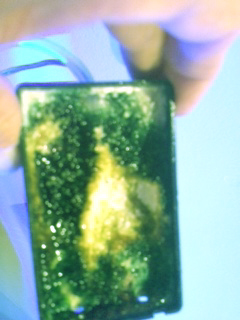 \"The [scrubber] is working well\" -- JT Powell \"All I can say about the [scrubber] is WoW. It completely wiped out my severe case of Cyano Bacteria in 4 weeks, it is working like a champ. I was a little skeptical that it would work at first because it\'s very compact, but I am completely amazed on how great it\'s working.\" -- John Quezada \"My [scrubber] is working great\" -- Stefan Kolev \"Happy to report that the [scrubber] is growing lots of hair algae\" -- Kidtango on the R2R site \"[Scrubber] is growing thick and fast\" -- Carl Knowles \"Boom... 7 days growth from my [scrubber]\" -- rdevoe11, pic: 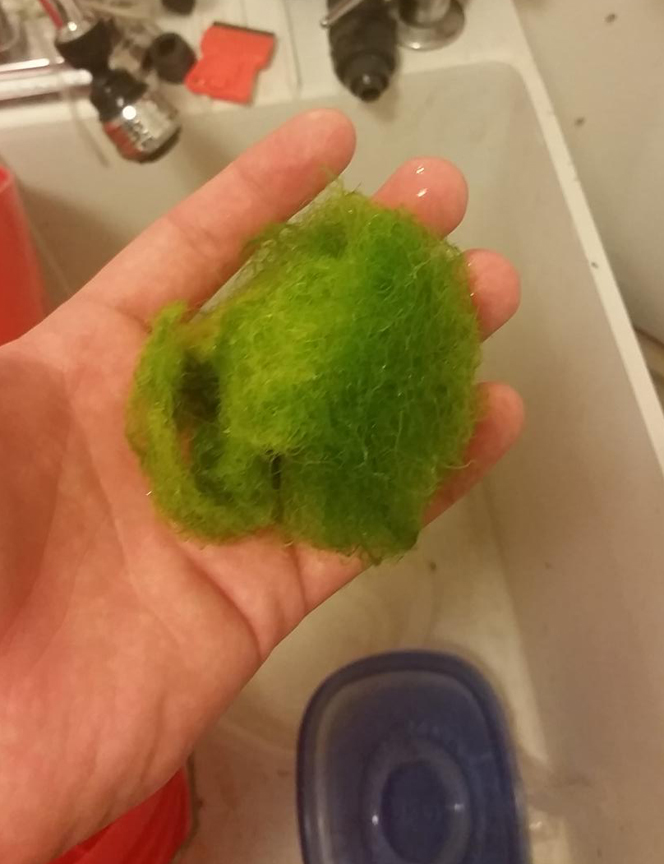 Other pics: Matthew Coulthard: 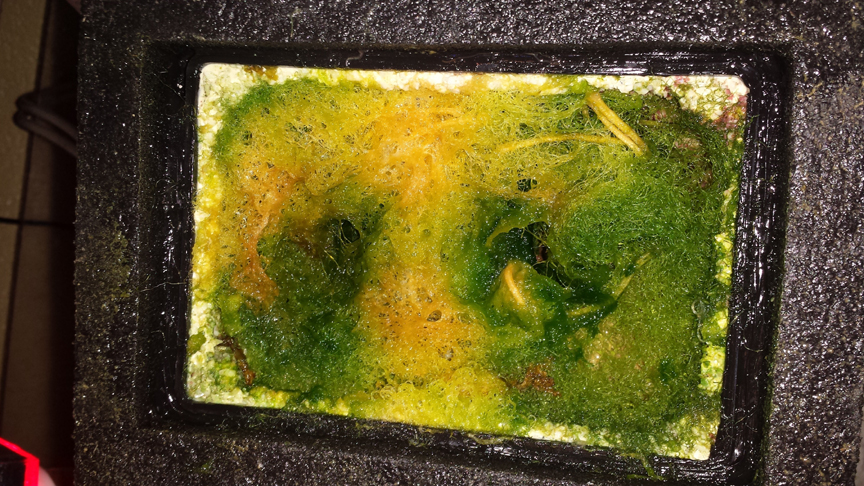 Nicolay Oganesian:  Yuppy Suhandinata:  - Nancy Research Studies: Reefba |
| SantaMonicaHelp Fingerling Posts: 22 Kudos: 7 Votes: 0 Registered: 29-Sep-2012  | Here are some upflow layout designs to give you ideas of what might fit your tank or ability to DIY better: http://www.algaescrubber.net/Post1.jpg (simple upflow screen) http://www.algaescrubber.net/Post2.jpg (attach to glass) http://www.algaescrubber.net/Post3.jpg (bubble remover) http://www.algaescrubber.net/Post4.jpg (attach to glass, with compartment) http://www.algaescrubber.net/Post5.jpg (attach to glass, small) http://www.algaescrubber.net/P6.jpg (hang on back) http://www.algaescrubber.net/P7.jpg (collector) http://www.algaescrubber.net/P7.jpg (floating) -NP Research Studies: Reefba |
This post has been deleted | |
| SantaMonicaHelp Fingerling Posts: 22 Kudos: 7 Votes: 0 Registered: 29-Sep-2012  | Dark Slime and Black Slime - what it looks like Here are some examples of dark slime, and black slime. Usually slime it starts on new scrubbers which have high measurable nutrients in the water, or on small scrubbers on big tanks with lots of rock where the scrubber is not big enough to pull the nutrients out fast enough. Notice that some of them have white patches; this is because the slime let go and floated away, leaving white surfaces behind. In all cases, just take it to your sink and toothbrush them (without toothpaste) so that you can see the white surfaces again.  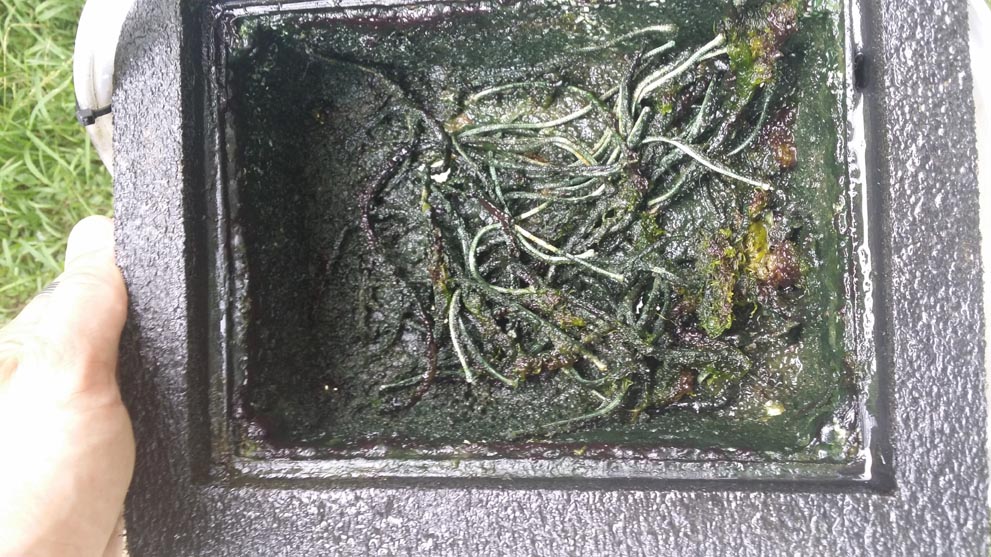  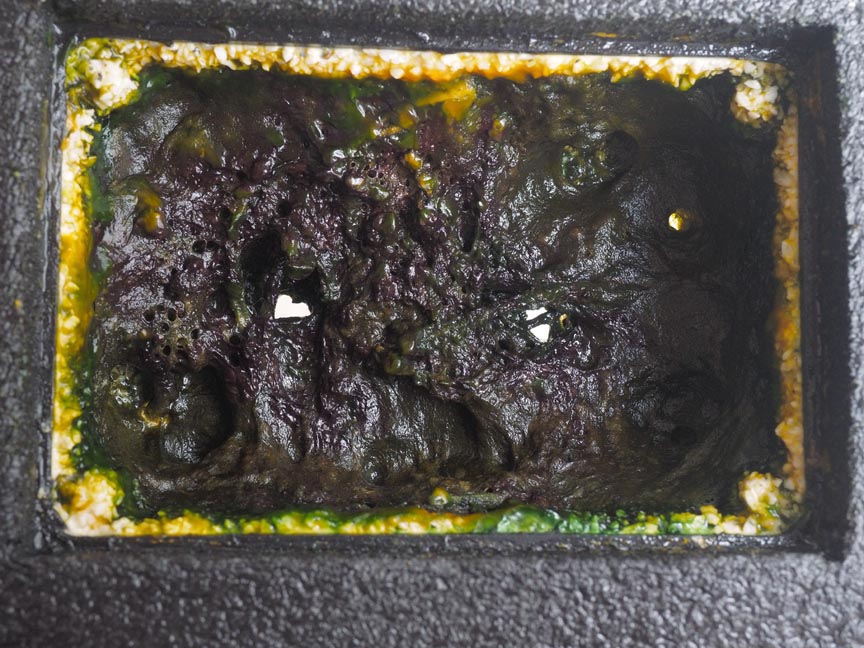     -NP Research Studies: Reefba |
santamonica Enthusiast Posts: 152 Kudos: 17 Registered: 19-Sep-2008   | Marine Biology Basics... the videos: http://www.youtube.com/watch?v=qfMaBeLwiO4 - Ocean Productivity http://www.youtube.com/watch?v=7d96F0ak4uY - Photosynthesis part 1 http://www.youtube.com/watch?v=WTBlq3gUv5Y - Food Chains vs. Food Webs http://www.youtube.com/watch?v=FwZDIU6sM_4& - Nutrients and Primary Production http://www.youtube.com/watch?v=SnlCx7mVcZ4 - Chlorophyll http://www.youtube.com/watch?v=LtZ75KW2t-U - Zooplankton and Primary Production http://www.youtube.com/watch?v=quH4x640Jgs - Bacteria http://www.youtube.com/watch?v=rdIjMQATQks - Food Webs http://www.youtube.com/watch?v=bc_fGWjmNeI - Microbial Food Web http://www.youtube.com/watch?v=pQaE0e0iD3s - Trophic Pyramids 888-CORAL-REEF Filtering discussion: www.AlgaeScrubber.net |
santamonica Enthusiast Posts: 152 Kudos: 17 Registered: 19-Sep-2008   | Photosynthesis Lighting Test: Duration: 4 months Harvests: 13 Location: Saltwater Lights: 3-watt 660 nm (red) LEDs, 500 ma. Photoperiod: 18 hours Air bubble flow: 24 hours  888-CORAL-REEF Filtering discussion: www.AlgaeScrubber.net |
santamonica Enthusiast Posts: 152 Kudos: 17 Registered: 19-Sep-2008   | Here are some upflow layout designs to give you ideas of what might fit your tank or ability to DIY better: Simple upflow screen:  Attach to glass: 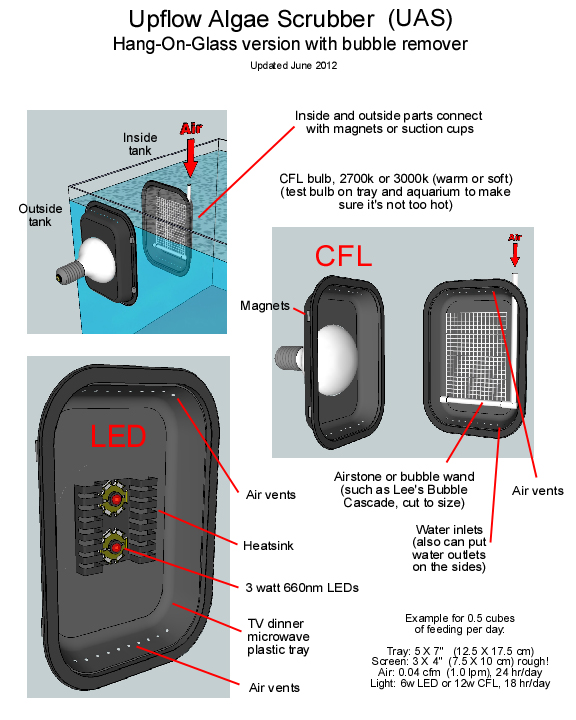 Bubble remover:  Attach to glass, with compartment: 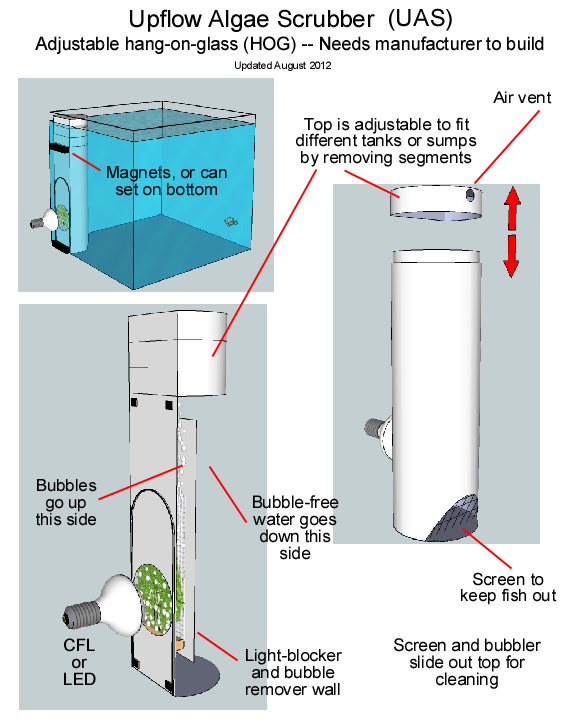 Attach to glass, small: 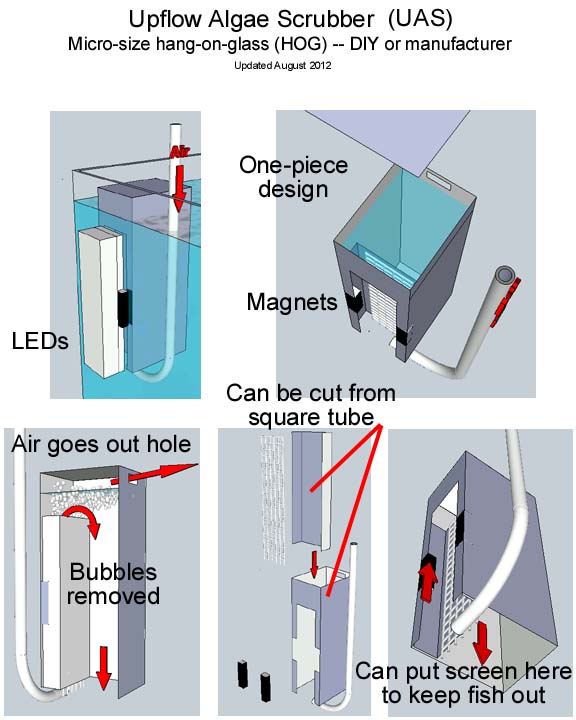 Hang on back:  Collector:  Floating:  888-CORAL-REEF Filtering discussion: www.AlgaeScrubber.net |
| SantaMonicaHelp Fingerling Posts: 22 Kudos: 7 Votes: 0 Registered: 29-Sep-2012  | Marine Biology Basics... the videos: http://www.youtube.com/watch?v=qfMaBeLwiO4 - Ocean Productivity http://www.youtube.com/watch?v=7d96F0ak4uY - Photosynthesis part 1 http://www.youtube.com/watch?v=WTBlq3gUv5Y - Food Chains vs. Food Webs http://www.youtube.com/watch?v=FwZDIU6sM_4& - Nutrients and Primary Production http://www.youtube.com/watch?v=SnlCx7mVcZ4 - Chlorophyll http://www.youtube.com/watch?v=LtZ75KW2t-U - Zooplankton and Primary Production http://www.youtube.com/watch?v=quH4x640Jgs - Bacteria http://www.youtube.com/watch?v=rdIjMQATQks - Food Webs http://www.youtube.com/watch?v=bc_fGWjmNeI - Microbial Food Web http://www.youtube.com/watch?v=pQaE0e0iD3s - Trophic Pyramids - C. Smith Research Studies: Reefba |
| Jump to: |
The views expressed on this page are the implied opinions of their respective authors.
Under no circumstances do the comments on this page represent the opinions of the staff of FishProfiles.com.
FishProfiles.com Forums, version 11.0
Mazeguy Smilies